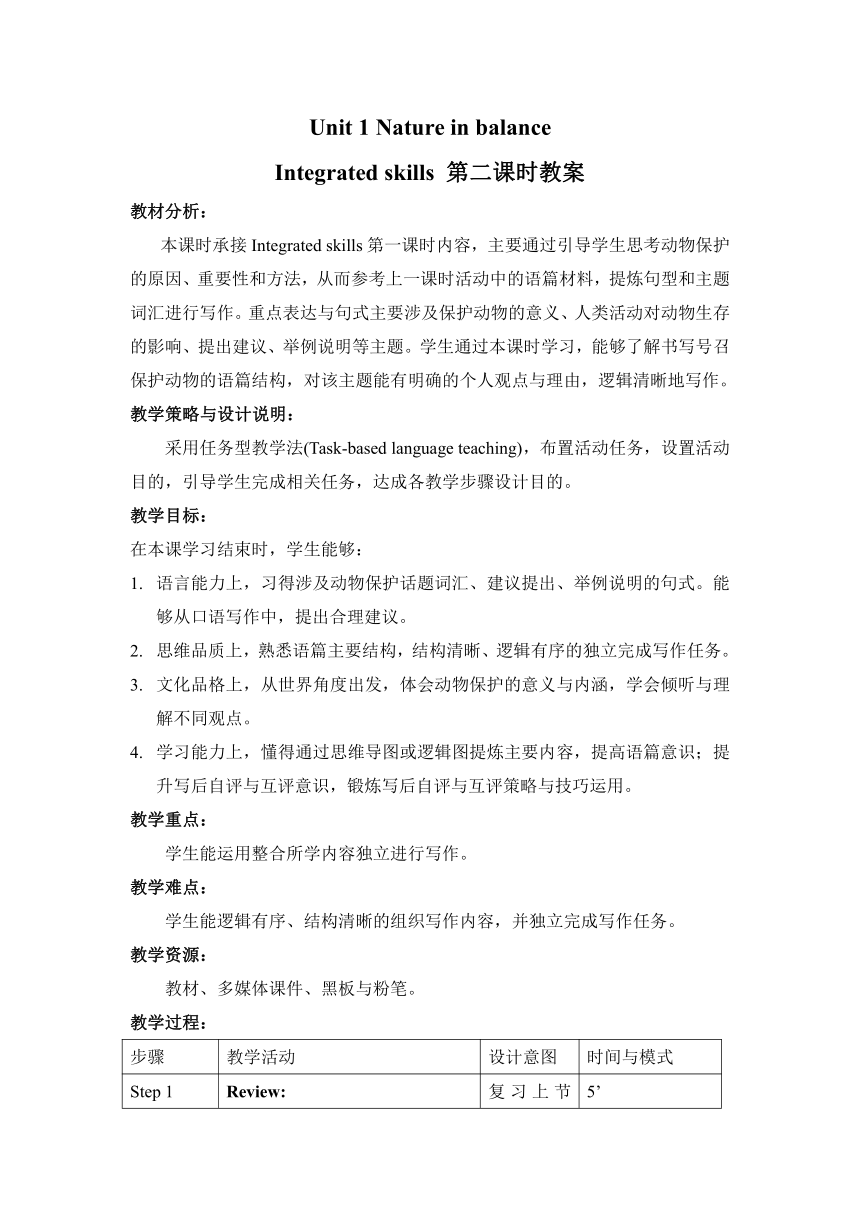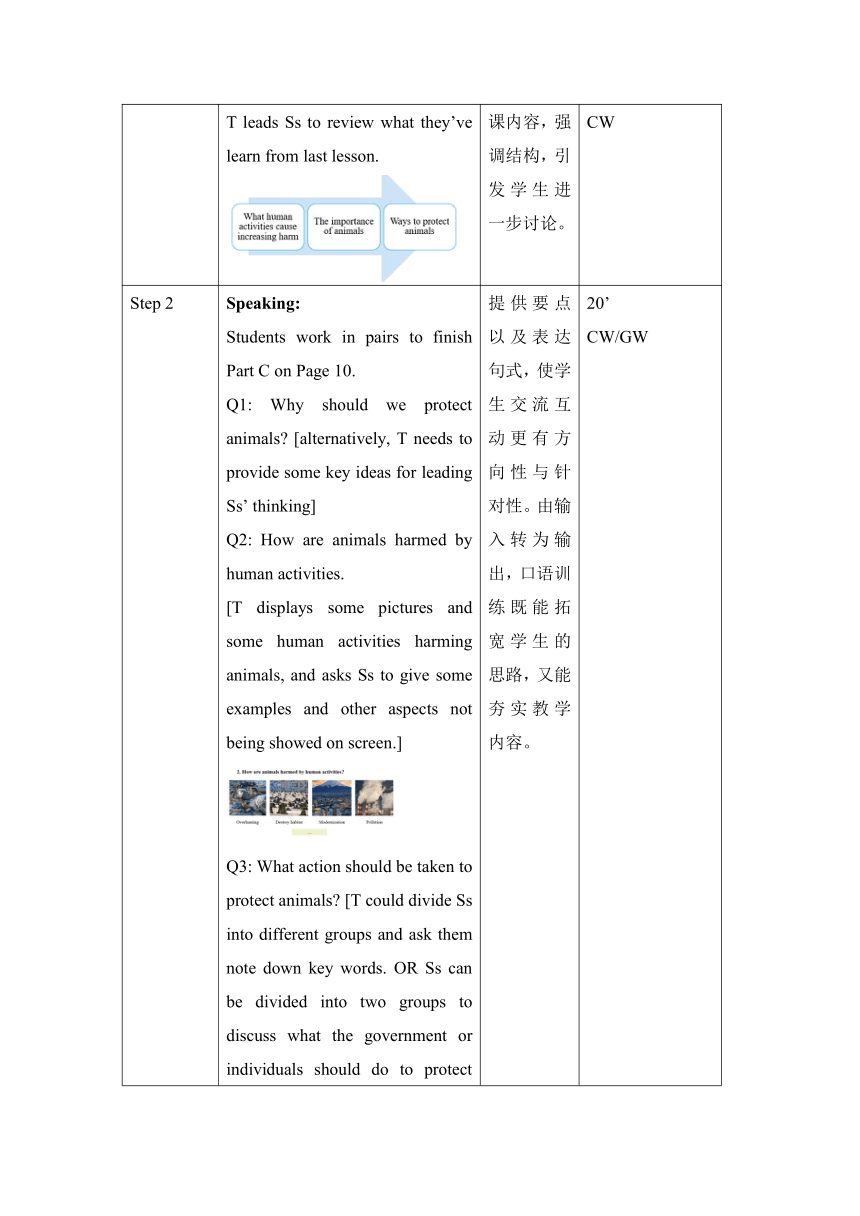牛津译林版(2019)必修 第三册Unit 1 Nature in the balance Integrated skills 第二课时教案-(表格式)
文档属性
| 名称 | 牛津译林版(2019)必修 第三册Unit 1 Nature in the balance Integrated skills 第二课时教案-(表格式) |  | |
| 格式 | docx | ||
| 文件大小 | 138.7KB | ||
| 资源类型 | 教案 | ||
| 版本资源 | 牛津译林版(2019) | ||
| 科目 | 英语 | ||
| 更新时间 | 2024-04-03 11:48:20 | ||
图片预览


文档简介
Unit 1 Nature in balance
Integrated skills 第二课时教案
教材分析:
本课时承接Integrated skills第一课时内容,主要通过引导学生思考动物保护的原因、重要性和方法,从而参考上一课时活动中的语篇材料,提炼句型和主题词汇进行写作。重点表达与句式主要涉及保护动物的意义、人类活动对动物生存的影响、提出建议、举例说明等主题。学生通过本课时学习,能够了解书写号召保护动物的语篇结构,对该主题能有明确的个人观点与理由,逻辑清晰地写作。
教学策略与设计说明:
采用任务型教学法(Task-based language teaching),布置活动任务,设置活动目的,引导学生完成相关任务,达成各教学步骤设计目的。
教学目标:
在本课学习结束时,学生能够:
语言能力上,习得涉及动物保护话题词汇、建议提出、举例说明的句式。能够从口语写作中,提出合理建议。
思维品质上,熟悉语篇主要结构,结构清晰、逻辑有序的独立完成写作任务。
文化品格上,从世界角度出发,体会动物保护的意义与内涵,学会倾听与理解不同观点。
学习能力上,懂得通过思维导图或逻辑图提炼主要内容,提高语篇意识;提升写后自评与互评意识,锻炼写后自评与互评策略与技巧运用。
教学重点:
学生能运用整合所学内容独立进行写作。
教学难点:
学生能逻辑有序、结构清晰的组织写作内容,并独立完成写作任务。
教学资源:
教材、多媒体课件、黑板与粉笔。
教学过程:
步骤 教学活动 设计意图 时间与模式
Step 1 Review: T leads Ss to review what they’ve learn from last lesson. 复习上节课内容,强调结构,引发学生进一步讨论。 5’ CW
Step 2 Speaking: Students work in pairs to finish Part C on Page 10. Q1: Why should we protect animals [alternatively, T needs to provide some key ideas for leading Ss’ thinking] Q2: How are animals harmed by human activities. [T displays some pictures and some human activities harming animals, and asks Ss to give some examples and other aspects not being showed on screen.] Q3: What action should be taken to protect animals [T could divide Ss into different groups and ask them note down key words. OR Ss can be divided into two groups to discuss what the government or individuals should do to protect animals.] After noting down, T shows some useful expression, and asks Ss to link key words together. The discussion should be 10mins, T can pick several Ss to make a short speech. 提供要点以及表达句式,使学生交流互动更有方向性与针对性。由输入转为输出,口语训练既能拓宽学生的思路,又能夯实教学内容。 20’ CW/GW
Step 3 Watch a video T plays a short video to sum up the ways of diversity protection, and guides Ss to know the urgency of the action visually. 通过视频,立体了解动物现状和解决方法。活跃课堂氛围,拓展思路。 5’ CW
Step 4 Pre-writing: Firstly, T tells what a passage calling for everyone is, and asks Ss to care readers: people in school. Specifically, Ss should use first-person point of view and present simple tense. It is a good idea to give examples. You can also use powerful and emotive words and phrases to make a strong impact on the reader. 了解语篇用途和含义,使学生提高对语篇的认识,为后续做铺垫。 5’ CW
Step 5 Pre-writing: T analyses three main parts of the article. State the importance of protecting animals. [T leads Ss to consider the importance of protecting animals by ask four questions, because of speaking part above, Ss can complete this part individually.] Explain how human activities harm animals. [T leads Ss to think about human directive and indirective activities and give some examples.] Come up with ways to protect animals. [T shows a mind map and guides Ss to think how to stretch the point and give examples] Then, T teaches useful expressions to help Ss make sentences more precise. Finally, T concludes writing steps. And Ss have 20-25 mins to write the article. 指导学生使用本课所学知识,注意写作的体裁、结构和语言。 30’ CW/IW
Step 6 Checking Students check their writings after they finish and exchange drafts with their partners for peer review. The teacher requires students checking if there are any mistakes in terms of punctuation, spelling, grammar, choice of words, style and structure. Students make comments on each other’s writing by giving praises, suggestions and corrections. 让学生评价自己的作文,引导其对自身习作进行批判性审视,对写作过程中发现的问题进行探究和调控,解决问题,学会学习。 15’ GW
Step 7 Homework: Write an article for an English magazine calling for everyone to protect Tibetan antelope. 同主题同文体写作,巩固新知 1’
备注:
Ss: Students T: Teacher
IW: Individual work GW: Group work CW: Class work
教学反思:
学生通过本课时学习,能否整合所学内容对动物保护话题进行交流讨论,并能逻辑有序、结构清晰地独立完成相关写作任务。
学生通过本课时学习,能否加深对动物保护的理解,了解其意义与重要性。
Integrated skills 第二课时教案
教材分析:
本课时承接Integrated skills第一课时内容,主要通过引导学生思考动物保护的原因、重要性和方法,从而参考上一课时活动中的语篇材料,提炼句型和主题词汇进行写作。重点表达与句式主要涉及保护动物的意义、人类活动对动物生存的影响、提出建议、举例说明等主题。学生通过本课时学习,能够了解书写号召保护动物的语篇结构,对该主题能有明确的个人观点与理由,逻辑清晰地写作。
教学策略与设计说明:
采用任务型教学法(Task-based language teaching),布置活动任务,设置活动目的,引导学生完成相关任务,达成各教学步骤设计目的。
教学目标:
在本课学习结束时,学生能够:
语言能力上,习得涉及动物保护话题词汇、建议提出、举例说明的句式。能够从口语写作中,提出合理建议。
思维品质上,熟悉语篇主要结构,结构清晰、逻辑有序的独立完成写作任务。
文化品格上,从世界角度出发,体会动物保护的意义与内涵,学会倾听与理解不同观点。
学习能力上,懂得通过思维导图或逻辑图提炼主要内容,提高语篇意识;提升写后自评与互评意识,锻炼写后自评与互评策略与技巧运用。
教学重点:
学生能运用整合所学内容独立进行写作。
教学难点:
学生能逻辑有序、结构清晰的组织写作内容,并独立完成写作任务。
教学资源:
教材、多媒体课件、黑板与粉笔。
教学过程:
步骤 教学活动 设计意图 时间与模式
Step 1 Review: T leads Ss to review what they’ve learn from last lesson. 复习上节课内容,强调结构,引发学生进一步讨论。 5’ CW
Step 2 Speaking: Students work in pairs to finish Part C on Page 10. Q1: Why should we protect animals [alternatively, T needs to provide some key ideas for leading Ss’ thinking] Q2: How are animals harmed by human activities. [T displays some pictures and some human activities harming animals, and asks Ss to give some examples and other aspects not being showed on screen.] Q3: What action should be taken to protect animals [T could divide Ss into different groups and ask them note down key words. OR Ss can be divided into two groups to discuss what the government or individuals should do to protect animals.] After noting down, T shows some useful expression, and asks Ss to link key words together. The discussion should be 10mins, T can pick several Ss to make a short speech. 提供要点以及表达句式,使学生交流互动更有方向性与针对性。由输入转为输出,口语训练既能拓宽学生的思路,又能夯实教学内容。 20’ CW/GW
Step 3 Watch a video T plays a short video to sum up the ways of diversity protection, and guides Ss to know the urgency of the action visually. 通过视频,立体了解动物现状和解决方法。活跃课堂氛围,拓展思路。 5’ CW
Step 4 Pre-writing: Firstly, T tells what a passage calling for everyone is, and asks Ss to care readers: people in school. Specifically, Ss should use first-person point of view and present simple tense. It is a good idea to give examples. You can also use powerful and emotive words and phrases to make a strong impact on the reader. 了解语篇用途和含义,使学生提高对语篇的认识,为后续做铺垫。 5’ CW
Step 5 Pre-writing: T analyses three main parts of the article. State the importance of protecting animals. [T leads Ss to consider the importance of protecting animals by ask four questions, because of speaking part above, Ss can complete this part individually.] Explain how human activities harm animals. [T leads Ss to think about human directive and indirective activities and give some examples.] Come up with ways to protect animals. [T shows a mind map and guides Ss to think how to stretch the point and give examples] Then, T teaches useful expressions to help Ss make sentences more precise. Finally, T concludes writing steps. And Ss have 20-25 mins to write the article. 指导学生使用本课所学知识,注意写作的体裁、结构和语言。 30’ CW/IW
Step 6 Checking Students check their writings after they finish and exchange drafts with their partners for peer review. The teacher requires students checking if there are any mistakes in terms of punctuation, spelling, grammar, choice of words, style and structure. Students make comments on each other’s writing by giving praises, suggestions and corrections. 让学生评价自己的作文,引导其对自身习作进行批判性审视,对写作过程中发现的问题进行探究和调控,解决问题,学会学习。 15’ GW
Step 7 Homework: Write an article for an English magazine calling for everyone to protect Tibetan antelope. 同主题同文体写作,巩固新知 1’
备注:
Ss: Students T: Teacher
IW: Individual work GW: Group work CW: Class work
教学反思:
学生通过本课时学习,能否整合所学内容对动物保护话题进行交流讨论,并能逻辑有序、结构清晰地独立完成相关写作任务。
学生通过本课时学习,能否加深对动物保护的理解,了解其意义与重要性。
同课章节目录
- Unit 1 Nature in the balance
- Welcome to the unit
- Reading
- Grammar and usage
- Integrated skills
- Extended reading
- Project
- Unit 2 Natural disasters
- Welcome to the unit
- Reading
- Grammar and usage
- Integrated skills
- Extended reading
- Project
- Unit 3 The world online
- Welcome to the unit
- Reading
- Grammar and usage
- Integrated skills
- Extended reading
- Project
- Unit 4 Scientists who changed the world
- Welcome to the unit
- Reading
- Grammar and usage
- Integrated skills
- Extended reading
- Project
